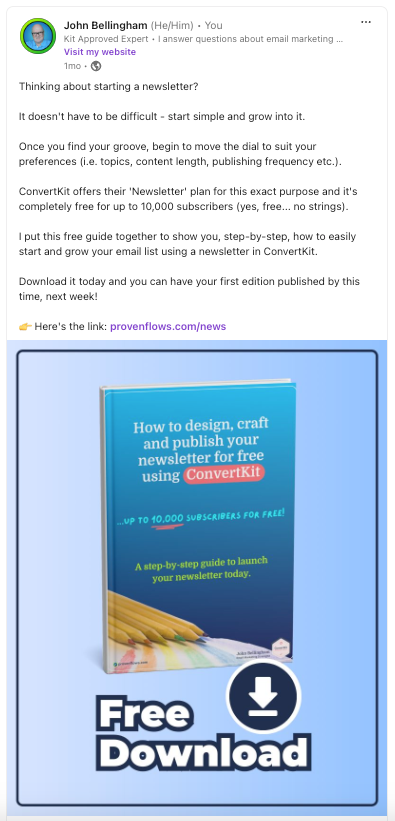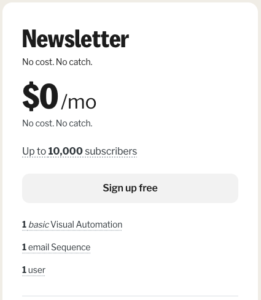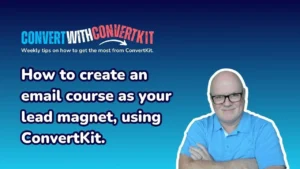Your strategy determines your outcome

Start with your 'main reason'
As a solo business owner, you need to be crystal clear about why your business exists. Everything you create, everything you do, and everything you provide is downstream of your ‘main reason’. Let me give you my business as an example of what I mean…
Whenever I’m asked what I do in my business, this is my reply…
“I teach service-based solo business owners how to grow their income and increase profits whilst using Kit as their email marketing platform.”
That’s it, one simple sentence.
Now, once we get into the details of what I do for each of my clients, there are dozens (maybe even hundreds!) of things, but this main reason serves as my North Star reminder of what I do, why I do it, and for whom.
And you need to to clear on yours too.
Next, answer these 4 key questions
Clients don’t just turn up at your door accidentally; they need a way of finding you, and it’s your job to guide them. The millions of potential email subscribers that are out there are just passers-by who have never heard of you – until you lead them to your email list.
1. What are you doing to get their attention?
Social platforms are the busiest digital platforms we have with a combined membership of more than 4 billion. The chances of anyone noticing you or your business without prompting are slim to none.
2. What are you using as your 'pathways'?
Taking an unknown passer-by from a social platform (or any other digital platform) to your email subscriber list takes thoughtful planning and careful, consistent execution. You need to have clearly signposted pathways they can take to get there.
3. What are you doing to nurture your subscribers?
Once on your email list, you need to regularly serve your subscribers with relevant and helpful content to assure them they're in the right place and they can trust you.
4. What do you sell that solves their problems?
You're in business to create a profit, so you must ensure you have what your subscribers need when they need it. You owe it to your subscribers, and yourself, to sell your products and services.
You need to spend time figuring out your answers to these questions because they’ll differ to mine (and every other business’s). Once you do, you’ll feel a sense of satisfaction descend upon you, and you may eve get an ‘ah-ha!’ moment as you analyse your ideal subscribers’ needs.
A proven email strategy for solo biz owners

The webinar has been crafted using visuals to help convey the strategy more easily and make the learning more memorable for you. As you watch it, take notes and use them to review afterwards as you scope out your version of the strategy I use in my business.
FAQs about email marketing strategy
Most people dive into email marketing head-first without giving much consideration to all the elements needed to make it a success. Once you wrap your head around how it all hangs together, you’ll begin to formulate a plan that’ll work perfectly for your particular needs.
If it all seems a bit vague at the moment, don’t worry – that’s commonplace. Here are a few questions I get asked regularly, together with my responses. If your question isn’t listed, send it to me and I’ll personally reply to you.
How do I grow my email list?
List growth requires an executable plan. You need to get clear out who you want on your list, figure out where they mostly hang out and then attract them with a free problem solver (commonly referred to as a ‘lead magnet’). People will naturally gravitate to your list of they recognise value in what you offer.
Do I need to use email software for email marketing?
Yes, commonly referred to as an email marketing platform (EMP) or email service provider (Email Service Provider). With an email marketing platform, you would not be able to (easily) do what you need to, to deliver a great experience for your subscribers.
There are many platforms to choose from, most offering free plans to get you started, together with a few premium plans when you need more functionality.
The one I use and recommend you do too (if you’re a service-based business owner) is Kit. Their free plan is very generous, allowing you to collect up to 10,000 subscribers on their free plan, which includes one automation and one email sequence – features normally reserved for premium plans.
What should I be sending my email subscribers?
In short, send them what they want from you. You’re the expert in your niche and have all the information that will help your subscribers to achieve what it is they want in their business (or life), so use that to keep them engaged and to keep you top-of-mind.
A good way of coming up with content ideas is to scroll through your own inbox and pick out the emails you enjoy (or appreciate) and figure out what it is about them you find attractive – then create that same feeling for your email list, in your niche.
It’s important to be a regular email sender, much more so than a prolific one.
How can I come up with ideas for my 'lead magnets'?
Should I buy a subscriber list to accelerate my growth?
- No. No, and no.
As tempting as buying an email list may be, it’ll end in tears further down the line, guaranteed! There are many reasons why you should never buy a list, but here are just a few;
- People on the list will have no idea who you are and unsubscribe, and probably mark your email as ‘spam’ and a complaint.
- ISP (the companies who host email inboxes, like Google, Yahoo, Apple etc.) will know you bought a list and start sending your emails to ‘spam’ folders.
- Companies who host email ‘blacklists’ will add your domain once you hit a ‘spam trap’ – this is when you send an email to an address they put in the list just to catch people who don’t get subscriber permission.
There are many more, but hopefully, these are enough to convince you to grow your email list properly and ethically.
Can I email subscribers to ask why they unsubscribed?
No. When an email subscriber unsubscribes from your list, your rights to send them emails ends. You can include an unsubscribe survey to capture reasons for leaving, however, any feedback left is not normally associated with the unsubscriber – the data can be useful to monitor general trends.
I haven't send any emails to my list for months - how can I get started again?
You need to bite the bullet and start to communicate with them again – a dorment list only deteriorates with time. Often, when re-engaging a list, you’ll get a bunch of unsubscribes, but that’s perfectly normal.
Some people will have forgotten who you are, might not remember subscribing, and may have lost interest in what it is you do.
If you have a large list, you should start the re-engagement process in segments, that way, your email marketing platform and the receiving ISPs can begin to recognise your sending domain again before you complete the entire list.
How do I get people from Facebook to my email list?
Getting your Facebook followers (or indeed, people from any social platform) to join your email list is simple (not to be confused with ‘easy’).
Offer them something that will help a problem you know they have, and in exchange, they give you their name and email address.
An example in my business is where I offer a guide on how to start a newsletter using Kit. The image below is how it looks on one of my social posts.

Can I change what website visitors see if they're subscribers to my email list?
Yes, you can change content on your website, making it more appealing and relevant to a visitor if they are a subscriber.
When you use Kit as your email marketing platform, you can share a personal ID for each subscriber and append it to URLs (i.e. the web page addresses).
An example of how it can be used would be to display a link to an article that is relevant to something they’re interested in.
Let’s imagine 2 subscribers visiting your website (by clicking a link in one of your emails) had differing topics of interest;
Subscriber A is interested in learning about Kit.
Subscriber B is interested in learning about LinkedIn.
By referencing the unique subscriber identifier (in the URL), your page would list article s about the topic of interest (i.e. all ‘Kit’ articles for subscriber A, and all ‘LinkedIn’ articles for subscriber B). Two visits to the same web page, with two very different experiences.
Can I add people to my subscriber list that I met at a meet-up?
Yes, you can add people you have met face-to-face, however, only with their express permission. You cannot ever add subscribers just because you met them and they gave you their business card – that’s a big no-no!
How can I automate my list-growth activity?
There are many tools and platforms you can use to create, curate, and publish your list-growth content, however, you should always make sure you’re fully across what you’re sharing – in other words, don’t capitulate your responsibilities to ‘own’ what you share by automating generic ‘AI-generated’ content.
One platform I use for scheduling is called Publer, which allows you to connect many of the most popular platforms like Facebook, Instagram, LinkedIn, and X (formerly Twitter).
These types of scheduling platforms also allow you to recycle content you’ve already created, meaning you can use popular content more than once.
Can I share my subscriber list with others? (and they share theirs with me)
Technically, yes, you can – but not something I would ever recommend you do. The best way to achieve a similar outcome is to agree on mutual promotions (with or without an affiliate agreement) of each other’s products and services.




